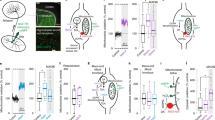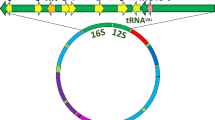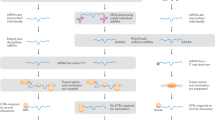Abstract
Monoamine oxidase (MAO, EC 1.4.3.4) is a mitochondrial outer membrane enzyme which deaminates amine transmitters in the nervous system and biogenic amines throughout the body. At least two types of MAO activity have been identified which differ in their specificities for substrates and sensitivities to inhibitors1–3. Type A preferentially deaminates 5-hydroxy-tryptamine and noradrenaline and is more sensitive to inhibition by clorgyline. Type B deaminates phenylethylamine and benzylamine and is more sensitive to inhibition by deprenyl. Tissues from several species express MAO A alone, MAO B alone, or both types of MAO. Furthermore, the two types of activity follow different developmental sequences in certain tissues. Models to explain the molecular and genetic regulation of this enzyme4 raise two questions: (1) are there different enzyme molecules associated with A and B types of activity, and (2) if there is only one enzyme molecule, how do differences in the microenvironment of this enzyme within the outer mitochondrial membrane produce two types of activity? Attempts to separate and purify the different types of activity have involved solubilisation and lipid extraction procedures that alter the kinetics of the enzyme and differentially affect the A and B types of activity5–8. Immunological studies9,10 have produced equivocal results. None of these observations has elucidated the molecular basis of the differences between the types of MAO activity. Here, we have used the technique of proteolytic digestion and peptide mapping to demonstrate that there are distinct enzyme molecules associated with the A and B types of MAO activity. This finding implies that the A and B forms of MAO may be coded for by separate gene loci and represent evolutionarily related proteins which have diverged in function.
This is a preview of subscription content, access via your institution
Access options
Subscribe to this journal
Receive 51 print issues and online access
$199.00 per year
only $3.90 per issue
Buy this article
- Purchase on Springer Link
- Instant access to full article PDF
Prices may be subject to local taxes which are calculated during checkout
Similar content being viewed by others
References
Neff, N. H. & Yang, H.-Y. T. Life Sci. 14, 2061–2074 (1974).
Houslay, M. D., Tipton, K. F. & Youdim, M. B. H. Life Sci. 19, 467–478 (1976).
Murphy, D. L. Biochem. Pharmac. 27, 1889–1893 (1978).
Breakefield, X. O., Cawthon, R. M., Costa, M. R. C., Edelstein, S. B. & Hawkins, M. Jr in Soc. Neurosci. Symp. 4 (ed. Ferrendelli, J. A.) 43–66 (Society for Neuroscience, Bethesda, 1979).
Houslay, M. D. & Tipton, K. F. Biochem. J. 135, 173–186 (1973).
Ekstedt, B. & Oreland, L. Biochem. Pharmac. 25, 119–124 (1976).
Kandaswami, C., Diaz Borges, J. M. & D'Iorio, A. Archs Biochem. Biophys. 183, 273–280 (1977).
McCauley, R. Archs Biochem. Biophys. 189, 8–13 (1978).
Dennick, R. G. & Mayer, R. J. Biochem. J. 161, 167–174 (1977).
McCauley, R. & Racker, E. Molec. Cell. Biochem. 1, 73–81 (1973).
Oreland, L., Kinemuchi, H. & Stigbrand, T. Archs Biochem. Biophys. 159, 854–860 (1973).
McCauley, R. Biochem. Pharmac. 25, 2214–2216 (1976).
Youdim, M. B. H. in Flavins and Flavoproteins (ed. Singer, T. P.) 593–609 (Elsevier, Amsterdam, 1976).
Costa, M. R. C. & Breakefield, X. O. Molec. Pharmac. 16, 242–249 (1979).
Edwards, D. J. & Pak, K. Y. Biochem. biophys. Res. Commun. 86, 350–357 (1979).
Chuang, H. Y. K., Patek, D. R. & Hellerman, L. J. boil. Chem. 249, 2381–2384 (1974).
Williams, C. H. & Lawson, J. Biochem. Pharmac. 24, 1889–1891 (1975).
Cleveland, D. W., Fischer, S. G., Kirschner, M. W. & Laemmli, U. K. J. biol. Chem. 252, 1102–1106 (1977).
Cabral, F. et al. J. biol. Chem. 253, 297–304 (1978).
Warren, T. G. & Mahowald, A. P. Devl Biol. 68, 130–139 (1979).
Murphy, D. L., Donnelly, C. H. & Richelson, E. J. Neurochem. 26, 1231–1235 (1976).
O'Farrell, P. Z., Goodman, H. M. & O'Farrell, P. H. Cell 12, 1133–1142 (1977).
Liu, A. Y-C. & Greengard, P. Proc. natn. Acad. Sci. U.S.A. 73, 568–572 (1976).
Maizel, J. V. Meth. Virol. 5, 179–224 (1971).
Horvitz, H. R. Nature new Biol. 244, 137–140 (1973).
Author information
Authors and Affiliations
Rights and permissions
About this article
Cite this article
Cawthon, R., Breakefield, X. Differences in A and B forms of monoamine oxidase revealed by limited proteolysis and peptide mapping. Nature 281, 692–694 (1979). https://doi.org/10.1038/281692a0
Received:
Accepted:
Issue Date:
DOI: https://doi.org/10.1038/281692a0
This article is cited by
-
Morphological and pharmacological analysis of putative serotonergic bipolar and amacrine cells in the retina of a turtle, Pseudemys scripta elegans
Cell and Tissue Research (1985)
-
Monoamine oxidase in young and adult rat brain capillaries
Journal of Neural Transmission (1984)
-
Monoamine oxidase (MAO) activity as a determinant in human neurophysiology
Behavior Genetics (1982)
-
Localization of monoamine oxidases A and B in primate brains relative to neuron-specific and non-neuronal enolases
Neurochemical Research (1982)
Comments
By submitting a comment you agree to abide by our Terms and Community Guidelines. If you find something abusive or that does not comply with our terms or guidelines please flag it as inappropriate.



